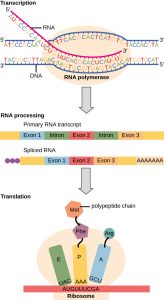Prokaryotic versus Eukaryotic Gene Expression
To understand how gene expression is regulated, we must first understand how a gene becomes a functional protein in a cell. The process occurs in both prokaryotic and eukaryotic cells, just in slightly different fashions.
Because prokaryotic organisms lack a cell nucleus, the processes of transcription and translation occur almost simultaneously. When the protein is no longer needed, transcription stops. When there is no mRNA present, no protein can be made. As a result, the primary method to control what type and how much protein is expressed in a prokaryotic cell is through the regulation of DNA transcription into RNA. All the subsequent steps happen automatically. When more protein is required, more transcription occurs. Therefore, in prokaryotic cells, the control of gene expression is almost entirely at the transcriptional level.
Eukaryotic cells, in contrast, have intracellular organelles and are much more complex. Recall that in eukaryotic cells, the DNA is contained inside the cell’s nucleus and that is where it is transcribed to produce mRNA. The newly synthesized mRNA is transported out of the nucleus into the cytoplasm, where ribosomes translate the mRNA to produce protein. The processes of transcription and translation are physically separated by the nuclear membrane; transcription occurs only within the nucleus, and translation only occurs outside the nucleus in the cytoplasm. The regulation of gene expression can occur at any stage of the process (Figure 1):
- Epigenetic level: regulates how tightly the DNA is wound around histone proteins to package it into chromosomes
- Transcriptional level: regulates how much transcription takes place
- Post-transcriptional level: regulates aspects of RNA processing (such as splicing) and transport out of the nucleus
- Translational level: regulates how much of the RNA is translated into protein
- Post-translational level: regulates how long the protein lasts after it has been made and whether the protein is processed into an active form

The differences in the regulation of gene expression between prokaryotes and eukaryotes are summarized in Table 1.
Table 1: Differences in the Regulation of Gene Expression of Prokaryotic and Eukaryotic Organisms
| Prokaryotic organisms | Eukaryotic organisms |
| Lack nucleus | Contain nucleus |
| RNA transcription and protein translation occur almost simultaneously |
RNA transcription occurs prior to protein translation, and it takes place in the nucleus. RNA translation to protein occurs in the cytoplasm. RNA post-processing includes addition of a 5′ cap, poly-A tail, and excision of introns and splicing of exons. |
| Gene expression is regulated primarily at the transcriptional level | Gene expression is regulated at many levels (epigenetic, transcriptional, post-transcriptional, translational, and posttranslational) |
References
Unless otherwise noted, images on this page are licensed under CC-BY 4.0 by OpenStax.
OpenStax, Concepts of Biology. OpenStax CNX. May 18, 2016 http://cnx.org/contents/b3c1e1d2-839c-42b0-a314-e119a8aafbdd@9.10

